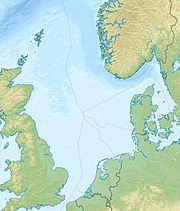Lunde Formation
| Lunde Formation | ||
|---|---|---|
Ma | ||
Approximate paleocoordinates 46°12′N 1°18′W / 46.2°N 1.3°W | | |
| Region | Snorre Field, North Sea | |
| Country | ||
| Extent | Northern Viking Graben | |
| Type section | ||
| Named for | Lunde | |
The Lunde Formation is a
Description
The Lunde Formation occurs in the northern part of a
With an approximate width of 400 kilometres (250 mi) between present mainland Norway and the
The climate during deposition of the Lunde Formation was semiarid and highly seasonal, typical for the contemporary palaeogeographic position at 40-50 degrees North paleolatitude.[1]
The basin was linked to a marine borealic seaway, probably located some tens to hundreds of kilometers to the north and to provenance areas composed of Archean gneisses, Caledonian metamorphic rocks and Devonian sandstones. These sources located on the Shetland Platform and in the southwestern area of Norway and deposited into a vast alluvial plain in the Triassic of what is now the North Sea.[1]
The bone slice of Plateosaurus was discovered during the description of a core retrieved in February 1997 from well 34/4-9S in the north-western part of the Snorre Field. It occurs in a reddish-brown, mudstone interval referred to as the upper member of the Lunde Formation.[3]
The mudstone is composed of dominantly compound and cumulative
Beds containing the bone specimen belong to the younger of two palynomorph assemblages containing the spore Kreuselisporites reissingeri thought to indicate an early Rhaetian rather than a Norian age, corresponding approximately to an age of 203-202 Ma according to the time scale of Gradstein et al. (2005).[3]
See also
- List of fossiliferous stratigraphic units in Norway
- List of fossiliferous stratigraphic units in Scotland
- Geology of Norway
- Geology of Scotland
- Geology of the North Sea
References
Bibliography
- Hurum, J.H.; M. Bergan; R. Müller; J.P. Nystuen, and N. Klein. 2006. A Late Triassic dinosaur bone, offshore Norway. Norwegian Journal of Geology 86. 117-123. Accessed 2019-10-12.

